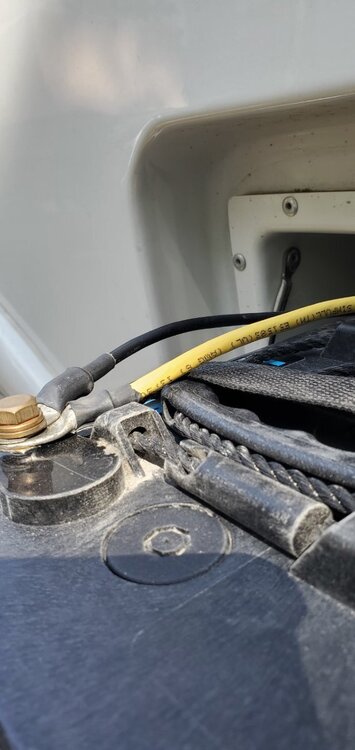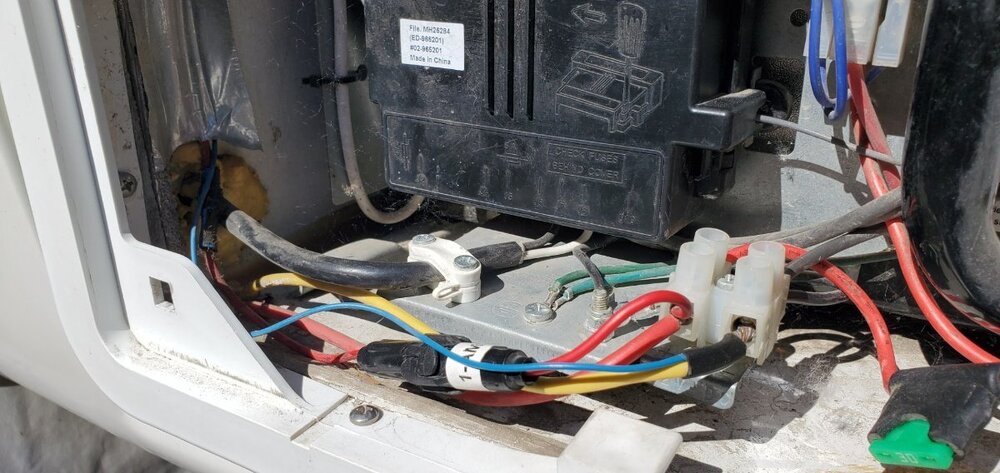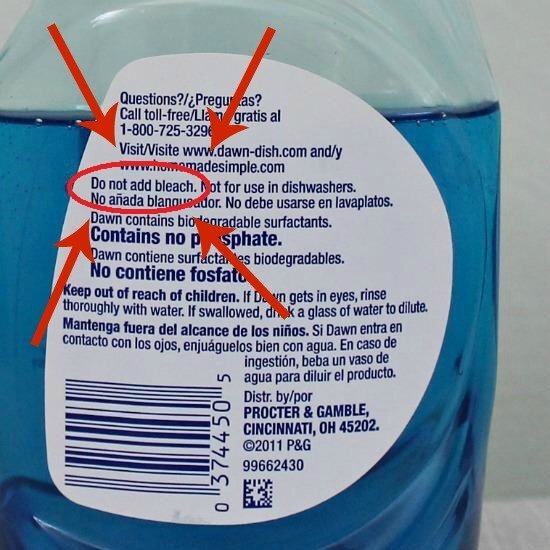-
Posts
389 -
Joined
-
Last visited
-
Days Won
20
Everything posted by DavePhelps
-
OK, let me try to get through everyone's good advice! 🙏 My new PD converter/charger module is the PD4045CSV, which puts out a max 45 amps. My solar array is 200 watts (Elite 1 remember). I think the newer models are a bit more.... I hope to add an aux 100 watt panel in the future, so 300 watts of panels. Yes, my Blue Sky charge controller is for the solar panels, and there is already a schunt installed that communicates with my Blue Sky IPN Remote display. It sounds like 6awg works for the solar side of my battery charging, but is lacking for the increased amp output of my new converter/charger? According to Snackchaser"s chart, 4awg wire would be the correct size, for the 45amp output of my converter/charger. I think I have enough OEM 6awg wire to install new crimp connectors and keep that wire in place from my charge controller . Some of the old ones were not so great. Even have some exposed wire on two connections that were over stripped and then the heat shrink was cut too short..... For the new converter/charger, I'll run new 4awg to the battery. Sounds like a plan is emerging! Not a lot of room in my trailer's electrical space under rear dinette seat, so glad I don't have to break in to my BS charge controller, it's kind of buried in there. Thanks again everyone for helping me through this. I'm good with the tools, but with the design side of electrical work I'm a bit lacking. Best, Dave PS. guess I'll also have to check the fuse from the converter/charger to battery to make sure it's rated for 45 amps.
-
My 9 year old AGM batteries are finally at the end of their life and I’ve decided to convert to a LiFePO4 battery system. One Epoch 12v 300ah battery I am looking at will fit nicely in my Legacy1 battery box and will have almost 2x the amp-hr capacity of my 2 6v AGM’s. . I have ordered a new Progressive Dynamics charger/converter module as my old one does not have the lithium switch or the other manual means to charge lithium batteries. So this is all good. My question is about the wiring. I do not have an inverter, nor do I plan to get one in the future. Between propane and 12VDC, I feel pretty comfortable. My current system however is wired with only 6awg wire. This seems way too small (or not??). The crimp connections are also of poor, bordering on dangerous quality. So I want to redo all the wiring from the batteries forward. Distances are short but with the new lithium batteries, I’m wondering what gauge wire is recommended? I have the Blue Sky charge controller and can’t find in the OM the max wire size it can accommodate. Any other ideas or cautions for this conversion would be appreciated! And thanks to those who have posted a lot of great info in other posts about this conversion. Cheers. Dave
-
I took both my torque wrenches to my auto mechanic. I've been a loyal customer and he was happy to take them. When the Snap-on truck stopped by, as they do fairly regularly, he had the calibration tools on hand in his truck as they regularly test/calibrate torque tools for all the shops they visit. One of my wrenches was a Snap-on, the other was a Precision Instrument. Fortunately, they both tested in spec. Good to know! Dave
-
I had the same issue with my aux cooling fan not coming on. Once again, the issue was a loose connection. That blue wire coming off the fan ends up coming out on the left side of the lower refir access panel. Look for the silver tape on the left side of the pic. There it combines with another yellow wire and inserts in to a terminal block (I believe that is what these are called?). In my case the blue wire was loose in the terminal block so I carefully braided the two wires together and reinstalled them in to the block. I bypassed the temp switch to verify all was well and the fan fired up, which it was not doing before. Now whether or not the temp switch is also bad is another story. I hope to test it next trip out. But check that blue wire connection at the terminal block! Good luck. Dave
-
This is unexpected, and a little concerning. On my 2015 LE1, the water heater and refrigerator have separate fuses, as they should. So to Ron and Phyllis, check your panel! Dave
-
How did you test this? I ask because if the problem you have is a grounding issue, then you may still have power to the receptacle. If you tested by using the hot and neutral wires supplied at the plug, and the neutral is bad, then your meter will show no power. Most all of my electrical issues have been with bad (loose) grounds. Hook up your meter to your supply (hot) wire and use another neutral/ground to see if you get power. If you do, then you know it's a grounding issue and you can start tracing that back to the bad connection. If you still have no power using a different ground, then most likely it is a supply line issue, so work back from there. Also, since your receptacle is out and disconnected, I'd do a continuity check to be sure it is functional. Finally, I have the Dometic 3-way refrigerator and there is a 5amp fuse for the AC heater hidden away in a control box attached to the back of the refir, accessed by removing the lower vent outside. Check your manual to see about yours. Time to buy a multimeter if you don't already have one! These issues can be challenging to trace. Just be methodical and don't ignore the grounding side of the tests. Good luck. Dave I edited this for some better clarity...I hope.
-
Wow, thanks for the update GJ!! I don't know if Dawn changed their formula, but back in the day, the label said "do not add bleach"! I checked my latest bottle and this warning was not on there! I love Dawn so am not disparaging it in any way. I will say, however, that when some bleach has found its way into my Dawn mix, the smell definitely changes and is more noxious. Maybe there is a Ollie chemist among us who can enlighten us.... Cheers, Dave
-
I'm pretty much on the same page with what Mike said above. With the black seals, I have never had a mildew issue, so haven't used bleach or other products as part of the cleaning process. My Ollie is stored out in the open, but if I lived where it was very hot and humid all summer, and mildew became an issue, I would change. Then I would wash the seals, then use a mild bleach solution, then 303.... Just don't add bleach to Dawn detergent if that is what you use. The ammonia in Dawn will combine with the bleach to make chlorine gas, not something you want to be breathing! The seals are easy to remove and replace and have to come off for window track cleaning anyway, so I try to get to them once a year if I can, sometimes I miss a year. Dave
-
I have the black seals. I take them out every year, and clean them with the same soap I'm washing the trailer with. After they're dry I give them a good wipe down with 303 Protectant. https://www.amazon.com/303-30313-CSR-Protectant-Plastic-Fiberglass/dp/B00KN0UOEE This has worked well and has kept the rubber supple, although they have shrunk a bit and don't fit completely around the perimeter of the windows. Maybe an inch short, the gap I place at the top. Can't remember if it came this way. I May replace them just for the tighter fit, but the 303 has otherwise kept them in good shape 8 years later. Dave
-
Talk of sealants always create quite a stir. Just go on any boating forum, look up sealants and stand back!! What I have used with success is this product: https://marineformula.com/products/marine-formula-10oz-aerosol Yes it's expensive, but I have been successful removing embedded silicone oils from the gelcoat with some wet sanding and a final polish. You will not sand through the gelcoat with 1200 grit paper! I would still do a reseal around the perimeter of your windows/fixtures as this is your first line of defense from water intrusion. It can be done well and look great. It just takes time, a good tape masking job, and an understanding of the ins and outs of the sealant you want to use. You don't know how good the butyl tape (if that is what was used) job was done under the windows during installation. So I would not take chances there. The pic of your window makes me cringe. Whoever did that really had no care for aesthetics or function. Use the Debond (there are also other products, but I haven't used them), a plastic razor to get the bulk of the old sealant off. Then go to the wet sand stage. Try to keep the Debond contained to the work area. Dribble a little on and start scraping. I just "resealed" my fender flares! Strictly an aesthetic decision! I think it looks much better. But certainly not necessary. Dave
-
Butyl tapes do indeed have strong adhesive qualities, and Bed-it is no exception. Of course, their sealant properties are their strength and the main reason for their use, but they also create a tenacious bond to whatever they stick to. https://www.generalsealants.com/butyl-tape-the-ultimate-guide/ Now if it is a structural application we're talking about, mechanical fastening would also be needed. But for the Oliver lense, I don't see that as necessary, and possibly a situation is being created where more pathways for water intrusion are being created by adding fasteners. My lense stuck tight to the butyl tape, then it was edge sealed, and several years later, being stored in the open outside in the PNW, not a leak. Everyone will have their system. I am intrigued by the Polyethers though. Unfortunately the tube of PL Marine I bought to try out was just a PITA to tool off (what the heck do you use???), and I threw it out and went back to my tried and true Sika 291. Maybe I had a bad tube. I may try the 3M version next as I like that Polyethers are compatible with more materials than polyurethane. I have had, however, no adverse reactions with the 291 on the Oliver lense, or the other plastic components on the trailer. If I was bedding these components, I would not use 291, but for edge sealing, so far so good. I do think though that the Polyether will be a more versatile and useful sealant going forward. Bummer about Oliver moving exclusively to silicone. They're not doing anyone any favors by going that route. Don't know what kind it is so waiting to hear more about it. Regarding silicone contamination of the gelcoat and future resealing issues. I have had good results wetsanding the afflicted area out with 1200 grit sandpaper and the appropriate solvent. When spritzing the area with water no longer beads up, the silicone oils have been removed. It's a pain but necessary if you want good adhesion, even if you plan to reseal with silicone...but don't do that!! Cheers. Dave
-

Trailer batteries not being charged by TV while under way
DavePhelps replied to DavePhelps's topic in General Discussion
Thanks JD for all your input. My batteries are the Lifeline AGM's and they have been great. In fact, I may just replace them with the same when the time comes as they have completely met our electrical needs over the years and have some advantages over the lithiums like cold weather charging, TV charging, and cost! The 30 amp automotive fuse for the fridge's DC heating element is seen when you remove the lower fridge vent/access cover. It's green as you can see in the pic below. Inside the black box on the left are two cartridge fuses: a 5A ac heater element fuse and a 3A control system fuse. We bought a fridge button guard from RV Widget Works as it is very easy to bump into those fridge selector buttons and change a setting. Happened to us a few times and since putting the guard on, no problems. http://www.rvwidgetworks.com/Photo-Gallery.html Thanks again for your tips and insights. Dave -

Trailer batteries not being charged by TV while under way
DavePhelps replied to DavePhelps's topic in General Discussion
Went back for another look and my setup is very similar to JD1923, minus all the inline fuses. This time I disconnected the black wire from the buss and retested with all power sources disconnected except my TV. That black wire tested 12.8V with my engine off and 14.5V with engine on. The buss was dead. So that mystery is solved at least. The crimp on that wire connector was pretty awful. I hope Oliver has upped their game with those. Onward. Dave -

Trailer batteries not being charged by TV while under way
DavePhelps replied to DavePhelps's topic in General Discussion
So the black wire you disconnected is the charge wire from your 7pin plug? This is what I have pretty much determined for mine. To check this, I disconnected the trailer batteries, shut off the solar, disconnected shore power, and plugged the 7pin into my TV. Multimeter showed 14.51 V at the bussbar. I didn't disconnect the black wire from the buss for the best test, but am pretty sure that black wire is the 7pin charge wire. Hopefully you agree! This leaves me a little stumped as to what my refir problems are now. Since my batteries are now 9 years old, I may get them load tested. Also, while checking the 30A in line blade fuse that protects the wiring for the refir's DC heating element, it pulled out broken. That could have been me as it was hard to pull out, but maybe a bad fuse was the issue. Have since learned that you can check those fuses for continuity without pulling them.... So there is more to work out. It might take another trip to see if it happens again. In the meantime, I'm learning a lot about my electrical system! Thanks for your response. Dave -
Seadawg, What do you use as a tooling lubricant for the PL marine? I had no luck with it using multiple different solvents. I went back to my Sika 291.... Also, with a quality butyl tape like Bed-it tape, I do not think mechanical fastening is necessary for something like the Oliver lense, unless you like the look. Mine stuck down with powerful tenacity. Then adhesive sealant was added to that. It's not going anywhere. Your choice! Dave
-
Another option, and one that I prefer to traditional saw toothed hole saws, are diamond grit hole saws. The hole is much cleaner and smoother, there is no chipping of the gelcoat, you have much more control with the cut, and no drama of worrying about the holesaw catching an edge and torquing your hand off or marring your work piece...especially on the larger holes. 5/8" will not be a worry with that here. 5/8" is pretty small, these probably won't have a pilot drill, but you can still use them effectively with the proper technique, or using a template as a guide. If you are set up to use Lenox hole saws and have the mandrel for it (and 7/8" isn't too big) I'd consider this: https://www.amazon.com/DG-HOLESAW-14DG-22-2MM-PK/dp/B002QMK8VQ/?_encoding=UTF8&pd_rd_w=Ou7U8&content-id=amzn1.sym.a725c7b8-b047-4210-9584-5391d2d91b93%3Aamzn1.symc.d10b1e54-47e4-4b2a-b42d-92fe6ebbe579&pf_rd_p=a725c7b8-b047-4210-9584-5391d2d91b93&pf_rd_r=EGJYD83A35XQGWK1X3ST&pd_rd_wg=HMKiX&pd_rd_r=ea23425b-78dc-49b7-9ce2-921c2afd6922&ref_=pd_hp_d_atf_ci_mcx_mr_hp_atf_m&th=1 Otherwise, I'd still get a 5/8" diamond grit (Bosch makes great smaller bits) without the pilot bit. Use water from a spritzer when drilling! Dave
-
Our favorite subject....sealants! That darn Oliver light strikes again. You may want to rethink not removing the lense, but I understand why you would not want to. My lense (hull 107) was "bedded" in some open cell foam weatherstripping. It was totally useless as a secondary barrier for the 3M 4200 that I think was applied around the perimeter of the lense. Thankfully it was not silicone. After a thorough cleaning, I used butyl tape to bed the lense, then Sikaflex 291 to seal around the edge. Several years later no leaks at all. There's been talk of the new polyether sealants on the market. I tried a tube and found it not very workable...maybe a bad tube? It was not past the expiration date. They say the polyethers play well with plastics where the polyurethanes do not, but I have not noticed any adverse reactions with my Oliver lense, and I like the 291 for everything else. If you want to give the polyether a try, and don't want to remove the lense, then maybe this is the way to go: https://www.westmarine.com/3m-4000-uv-fast-cure-polyether-adhesive-sealant-white-10-oz.-cartridge-3760196.html?queryID=d26afaac5e5422519ed7e4ec5eec6510&objectID=3760196&indexName=production_na01_westmarine_demandware_net__WestMarine__products__en_US Tape around the outer perimeter on the gelcoat, and you can tape the lense as well to help with getting clean lines. Take your time with the tape, use small pieces to define the radiused corners.Try not to get too much sealant in there! When you tool it off with a little paint thinner on your gloved finger, the sealant edge should just butt into the tape edge. If a lot of the sealant goes over the tape, then when you remove it, you're going to have a mess to deal with. Tool the sealant tight to the edge of the tape! Once the tape is off, a very light swipe with a thinner soaked gloved finger will smooth out the small ridges left from pulling the tape. Those ridges will collect dirt and look bad after a while so I think that last light swipe is important. Good luck. Keep an eye on your marker lights up there. One started to leak and the water ran down the wire to its low point, right over a neutral bussbar. Good luck! Dave
-

Trailer batteries not being charged by TV while under way
DavePhelps replied to DavePhelps's topic in General Discussion
Thanks Galway Girl, but my system is much different from yours. It has similar fuses and busses, but not much else looks familiar. I guess I'll need to call Oliver. None of the fuses have tripped. Will have to keep digging on this..... Dave -
This is a new development. I don't like to travel with my propane on, and have always traveled with my fridge (Dometic 3 way) in DC mode. Up until now, I have always arrived at camp with 100% trailer batteries (I have the two 6v AGM's in series) and a cold fridge. This last trip, when I got home, there was a pulsing noise from out of the black box located behind the lower access/vent panel for the fridge. When I turned on the overhead lights in the trailer, they pulsed in sync with the refir. Batteries were down to 74%, and fridge was up to 40 degrees. After checking all the fuses I could locate (all good) I took my multimeter and checked the 7 pin plug on my TV, which read 14.43 V, so that is not the problem. With the trailer now plugged in to 120V ac, batteries charged right up to full pretty fast (13.68V after resting). I then checked the fridge on AC, no issue. Then on DC, no issue, and no pulsing noise anymore. Then on propane, no issue. Somewhere, between the trailer's 7 pin connector and the trailer batteries, there is a problem, the batteries are not being charged. My Elite is a 2015 model and I hear that the charge wire from the 7 pin plug goes straight to the batteries, but not sure. Anyone know the color? I've seen diagrams where it is black or red.... There is a black wire coming off the batteries but it seems to go to my Blue Sky charge controller. Thought I'd ask here first before calling Oliver. Also, being new to DC systems, I assume it is best practice to disconnect the batteries, and the solar input before diving in to the system? Of course, I'd disconnect the AC as well! Thanks for any ideas, always appreciated. Dave
-
One last tip that I could add is that I always leave my safety chains (or cables if you have those) attached until the very end of setting up. After a long drive, potential bad weather, and road weariness has set in, things can go sideways in a hurry! Lots of great tips above. Never put my van in neutral before but will start doing that. And always chock both sides of your wheels.👍 Dave
-
This has always been a problem for me. Just how do you get those things out? It would seem you have to lift up and remove the glass but I can't do that either.... John, I also am in Portland and store my Ollie outside uncovered. Wish I had a cover but that's another story. In the winter, I keep the trailer plugged in with one of those oil filled radiators going inside at its lowest setting. I leave the bathroom window open a crack, unless I know a big freeze is coming. And also have my shades closed, though you may want to try leaving them open an inch or two for ventilation. I also always have some short pieces of paracord stuffed in the weep holes of the windows to aid water drainage out of the track. This was talked about a while back and it really helps keep the tracks dry. Those narrow weep holes do not drain water very effectively, but the paracord sucks the water out like a lantern wick. Some folks use pipe cleaners, but I have lots of paracord so use that with great success. Keeping those tracks clean is also important as Topgun2 mentioned. It's one of my least favorite maintenance jobs! Still trying to figure out an effective way to do it. With all of the above procedures employed, I have never had a mold issue. As for getting the mold out, maybe a distilled white vinegar/water solution as an alternative to bleach? Hopefully someone will have a solid idea. Good luck, Dave .picasa.ini
-

What exterior caulk is the factory using now?
DavePhelps replied to Townesw's topic in Mechanical & Technical Tips
Man I hear you! And that is a pretty gnarly sealant job on your rear window!😖 I pretty much have to tape everything off on each side of the joint (sometimes, just one side is necessary). It takes time, but gives me the best result. I'll wet tool the sealant before removing the tape. Then a final very light tooling (my finger usually) to take the tape/sealant edge off after tape is removed. It's important not to get too much sealant in the joint or you'll have a mess removing the tape and too thick an edge for the final tooling. The thinner tapes leave less of an edge to deal with. I'm still trying different things to get the clean look I want. I bought some silicone finishing tools I want to try next time I get in to it. Dave -

What exterior caulk is the factory using now?
DavePhelps replied to Townesw's topic in Mechanical & Technical Tips
I've been using SIKAFLEX 291 on my Ollie. It has a very good reputation in the marine world. I have experienced no yellowing or mildewing in the years I have used it. The world of sealants is a tough one. There is a lot of chemistry involved that is far beyond my knowledge for sure. Everyone is going to have their favorite based on their use and experience. Not sure why Oliver went to silicone, I'm sure they had their reasons. Although the ASI 335 seems to be a very good product, inevitable future resealing efforts may be compromised unless a very thorough cleaning protocol is adhered to. Not sure what is happening with the yellowing issues some folks are having. It could be quite a few things, part of the mysterious chemical peculiarities of sealants. THIS article may shed some light on that. Since the ASI 335 is neutral cure, it may be susceptible to yellowing from chemical vapor contamination from the butyl tape (or whatever Oliver is using now) around their windows. Don't know how widespread this issue is, or if this is indeed the issue at all. It's just part of the puzzle. The thing about sealants, and all materials really, is that they are part of an ecosystem where everyone has to get along or bad things happen. One needs to consider how multiple materials will interact with each other, both in the short and long term, for good work to be done. Dave -

What exterior caulk is the factory using now?
DavePhelps replied to Townesw's topic in Mechanical & Technical Tips
Scuba Rx, that ASI 0240 sounds pretty good. Especially interesting it can be used as a tooling lubricant. I will try that. What I have been using with great success is Debond, and it is even more expensive! So I think it's going to cost you Geronimo John! Debond The big problem with silicone from a refinishing point of view are the oils it contains. You can clean it off with solvents and plastic razors to where the gelcoat looks pristine, but when you spray the surface with water, it still beads up all over. This is caused by the silicone oils having penetrated the pores of the gelcoat. Not completely removing these oils will interfere with the full bonding of any sealant you want to use, including silicone! You have to break out some 1000 grit automotive sandpaper and wet sand it out with the solvent of your choice (in my case, Debond). When it's all gone, I hit it with some finer grit (1200-1500), then a good polishing cleaner. The gelcoat will then look great, and be ready to be sealed, and most importantly, the sealant will adhere to the gelcoat! All this work is why I never use silicones to begin with, except in some rare instances. Also, if you do any finishing in your shop, be extremely careful to keep any rags, pads, sandpaper, or anything that was used cleaning your silicone problem separate and away from your regular shop supplies. Silicone contamination in your shop can be a total disaster for the finisher. Good luck! Dave- 31 replies
-
- 10
-

-

-

-
Please post any future findings about this break. Has anyone tried bending the hitch back together to see if the break closes cleanly? I am seeing some things in the pics that are a little disturbing. Like in the above pics where there is rust in the center of the fracture and clean bright metal at the top and bottom. Maybe someone else can explain how this can happen. The rust edges also appear to be radiused. I'm no metallurgist so can only comment to what I am seeing. Hopefully, there will be a good explanation in the future on how this happened. Again, very glad you are all safe and back on the road with the new and larger Bulldog. Dave







